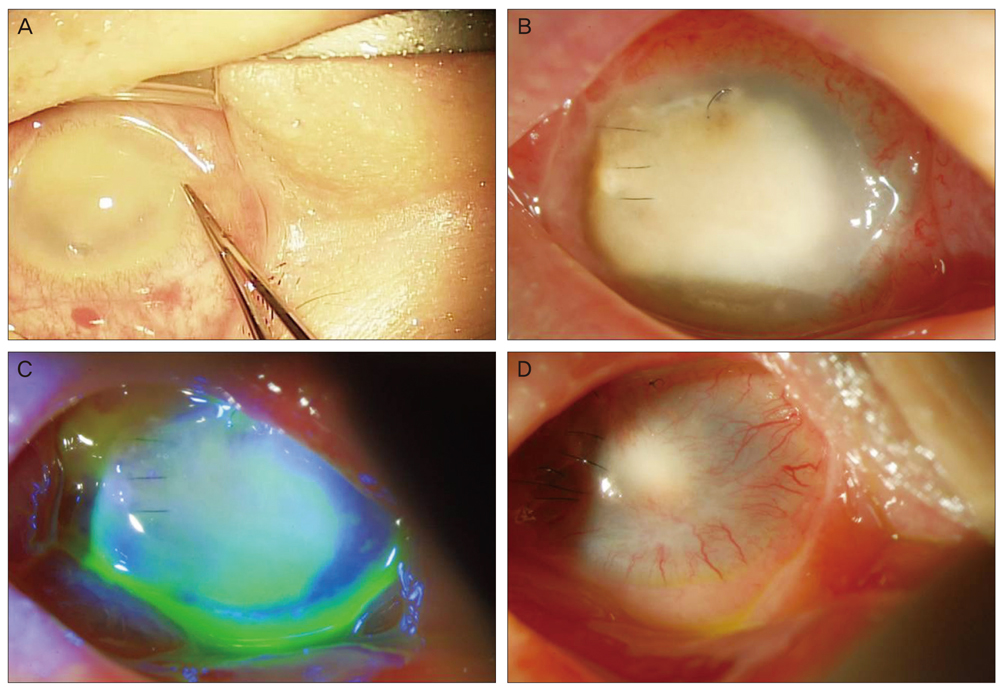Korean J Ophthalmol.
2012 Aug;26(4):306-308. 10.3341/kjo.2012.26.4.306.
A Case of Postoperative Endophthalmitis by Extended-spectrum Beta-lactamase-producing Escherichia coli
- Affiliations
-
- 1Department of Ophthalmology, Dongsan Medical Center, Keimyung University School of Medicine, Daegu, Korea. kimks@dsmc.or.kr
- KMID: 1387400
- DOI: http://doi.org/10.3341/kjo.2012.26.4.306
Abstract
- A 75-year-old female was transferred to our clinic three days after uneventful phacoemulsification with intraocular lens (IOL) implantation in the right eye that had been carried out at a local clinic. Under the diagnosis of postoperative endophthalmitis, the patient underwent pars plans vitrectomy, IOL explantation, silicone oil tamponade, and intravitreal antibiotic injection. Even after the procedure, the patient's condition was further aggravated, and extended-spectrum beta-lactamase-producing Escherichia coli were identified on bacterial identification test. Although meropenem was applied locally and systemically, the patient had no-light perception visual acuity.
Keyword
MeSH Terms
Figure
Reference
-
1. Meredith TA. Ryan SJ, Wilkinson CP, editors. Vitrectomy for infectious endophthalmitis. Retina. Vol. 3. Surgical retina. 2006. 4th ed. Philadelphia: Elsevier/Mosby;2255–2276.2. Microbiologic factors and visual outcome in the endophthalmitis vitrectomy study. Am J Ophthalmol. 1996. 122:830–846.3. Major JC Jr, Engelbert M, Flynn HW Jr, et al. Staphylococcus aureus endophthalmitis: antibiotic susceptibilities, methicillin resistance, and clinical outcomes. Am J Ophthalmol. 2010. 149:278–283.e1.4. Knothe H, Shah P, Krcmery V, et al. Transferable resistance to cefotaxime, cefoxitin, cefamandole and cefuroxime in clinical isolates of Klebsiella pneumoniae and Serratia marcescens. Infection. 1983. 11:315–317.5. Philippon A, Labia R, Jacoby G. Extended-spectrum beta-lactamases. Antimicrob Agents Chemother. 1989. 33:1131–1136.6. Endophthalmitis Vitrectomy Study Group. Results of the Endophthalmitis Vitrectomy Study: a randomized trial of immediate vitrectomy and of intravenous antibiotics for the treatment of postoperative bacterial endophthalmitis. Arch Ophthalmol. 1995. 113:1479–1496.7. Loewenstein A, Zemel E, Lazar M, Perlman I. Drug-induced retinal toxicity in albino rabbits: the effects of imipenem and aztreonam. Invest Ophthalmol Vis Sci. 1993. 34:3466–3476.8. Axelrod JL, Newton JC, Klein RM, et al. Penetration of imipenem into human aqueous and vitreous humor. Am J Ophthalmol. 1987. 104:649–653.9. Schauersberger J, Amon M, Wedrich A, et al. Penetration and decay of meropenem into the human aqueous humor and vitreous. J Ocul Pharmacol Ther. 1999. 15:439–445.
- Full Text Links
- Actions
-
Cited
- CITED
-
- Close
- Share
- Similar articles
-
- A Case Report of Sepsis by Extended-Spectrum beta-Lactamase Producing Escherichia Coli
- In Vitro Susceptibility of piperacillin/tazobactam Against extended-spectrum beta-lactamase-producing Escherichia coli and Klebsiella pneumoniae
- Risk Factors of Nosocomial Bacteremia of Extended-spectrum beta-Lactamase Producing Escherichia coli
- Comparison of MicroScan and Phoenix Automated Systems for Detection of Extended-Spectrum beta-Lactamase-Producing Escherichia coli and Klebsiella pneumoniae
- Community-onset Necrotizing Fasciitis Caused by Extended-spectrum Beta-lactamase-producing Eshcerichia coli


